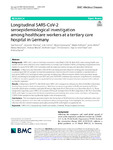2022-01-24Zeitschriftenartikel
Longitudinal SARS-CoV-2 seroepidemiological investigation among healthcare workers at a tertiary care hospital in Germany
Tomczyk, Sara
Hönning, Alexander
Hermes, Julia
Grossegesse, Marica
Hofmann, Natalie
Michel, Janine
Neumann, Markus
Nitsche, Andreas
Hoppe, Berthold
Eckmanns, Tim
Schmidt‑Traub, Hajo
Zappel, Kristina
Background:
SARS-CoV-2 cases in Germany increased in early March 2020. By April 2020, cases among health care workers (HCW) were detected across departments at a tertiary care hospital in Berlin, prompting a longitudinal investigation to assess HCW SARS-CoV-2 serostatus with an improved testing strategy and associated risk factors.
Methods:
In May/June and December 2020, HCWs voluntarily provided blood for serology and nasopharyngeal/oropharyngeal (NP/OP) samples for real-time polymerase chain reaction (PCR) and completed a questionnaire. A four-tiered SARS-CoV-2 serological testing strategy including two different enzyme-linked immunosorbent assays (ELISA) and biological neutralization test (NT) was used. ELISA-NT correlation was assessed using Pearson’s correlation coefficient. Sociodemographic and occupational factors associated with seropositivity were assessed with multivariate logistic regression.
Results:
In May/June, 18/1477 (1.2%) HCWs were SARS-CoV-2 seropositive, followed by 56/1223 (4.6%) in December. Among those tested in both, all seropositive in May/June remained seropositive by ELISA and positive by NT after 6 months. ELISA ratios correlated well with NT titres in May/June (R = 0.79) but less so in December (R = 0.41). Those seropositive reporting a past SARS-CoV-2 positive PCR result increased from 44.4% in May/June to 85.7% in December. HCWs with higher occupational risk (based on profession and working site), nurses, males, and those self-reporting COVID-19-like symptoms had significantly higher odds of seropositivity.
Conclusions:
This investigation provides insight into the burden of HCW infection in this local outbreak context and the antibody dynamics over time with an improved robust testing strategy. It also highlights the continued need for effective infection control measures particularly among HCWs with higher occupational risk.
Dateien zu dieser Publikation

